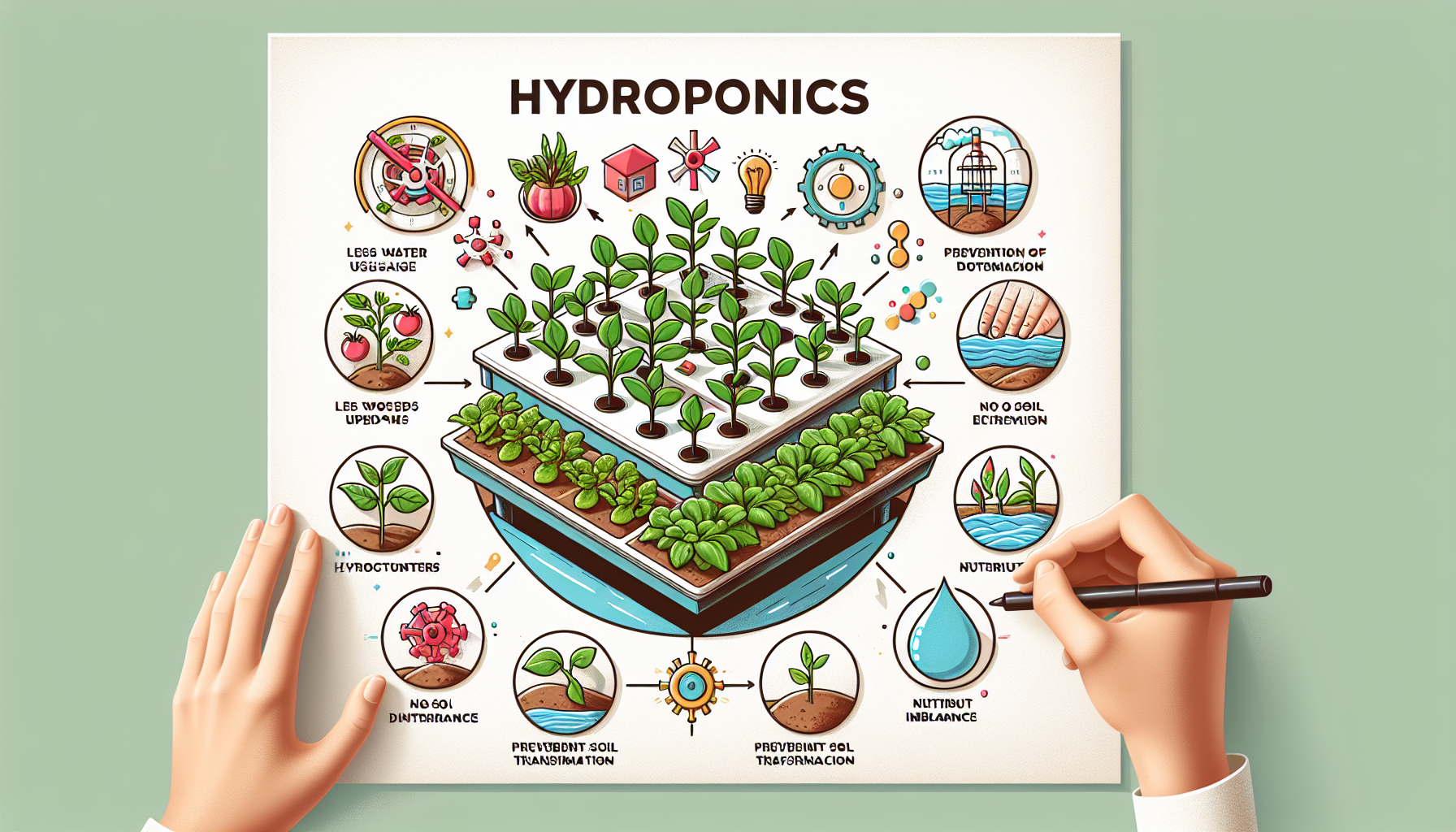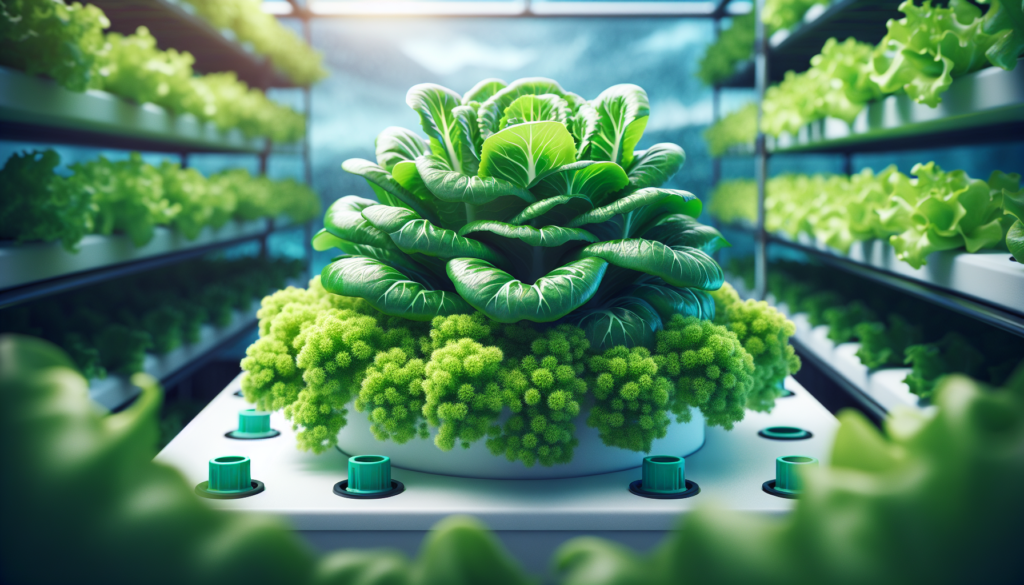Imagine a gardening method where you can grow plants without the need for soil, under carefully controlled conditions using nutrient-rich water. It’s called hydroponics, and it’s revolutionizing the way we cultivate crops. But how healthy is hydroponics, really? This article aims to explore the various benefits and potential drawbacks of this innovative gardening technique, offering insights into its impact on plant growth, nutrition, and environmental sustainability. So, if you’re curious to know if hydroponics is as healthy for you and the planet as it is for your plants, keep reading!

Benefits of Hydroponics
Reduced pesticide use
One of the major benefits of hydroponics is the reduced use of pesticides. In traditional agriculture, crops are often sprayed with chemical pesticides to control pests and disease. However, in hydroponic systems, pests and diseases are less likely to occur due to the controlled environment. This means that farmers can greatly reduce or even eliminate the need for chemical pesticides, resulting in healthier and safer produce.
Water and resource conservation
Hydroponic systems are incredibly efficient when it comes to water and resource conservation. Unlike conventional farming, which requires large amounts of water to irrigate crops, hydroponics uses a recirculating system that only requires a fraction of the water. The water is constantly reused, significantly reducing water waste. Additionally, hydroponics also eliminates the need for soil, reducing the amount of land required for farming, as well as the use of fertilizers and other resources.
Year-round production
One of the advantages of hydroponics is its ability to enable year-round production. Traditional farming is often limited by factors such as climate and seasonal changes, which can affect crop growth and yield. With hydroponics, farmers have full control over the growing environment, including temperature, humidity, and lighting. This allows for continuous crop production regardless of the time of year, ensuring a steady and consistent supply of fresh produce.
Higher crop yields
Hydroponic systems have been shown to produce higher crop yields compared to conventional agriculture. By providing plants with optimum growing conditions, including a constant supply of water, nutrients, and controlled climate, plants are able to grow faster and produce more fruits or vegetables. This increased efficiency in crop production can result in higher yields, allowing farmers to grow more food in a smaller area. This not only maximizes productivity but also helps meet the growing demand for food in a sustainable manner.
Nutrient Management in Hydroponics
Optimal nutrient levels
One of the key components of successful hydroponics is achieving and maintaining optimal nutrient levels for plant growth. Hydroponic systems rely on nutrient solutions to provide plants with the necessary elements for their growth and development. By carefully monitoring and adjusting the nutrient levels in the solution, farmers can ensure that plants receive the right balance of nutrients needed for healthy growth.
Precise control of nutrient intake
Unlike traditional agriculture, where plants rely on the nutrients extracted from the soil, hydroponic plants receive their nutrients directly from the nutrient solution. This allows for precise control over the nutrient intake of each plant, ensuring that they receive exactly what they need for optimal growth. By adjusting the nutrient solution to meet the specific requirements of different plant species, farmers can maximize their growth potential and overall health.
Minimizing nutrient deficiencies
In hydroponic systems, the risk of nutrient deficiencies is significantly reduced. Since the plants are not dependent on the nutrients present in the soil, there is less chance of them lacking essential elements. This is particularly important for micronutrients, which are often found in limited quantities in traditional soil. By providing plants with a well-balanced nutrient solution, hydroponic systems can minimize the occurrence of nutrient deficiencies, leading to healthier and more productive plants.
Reduced risk of nutrient runoff
In traditional agriculture, excess nutrients applied to the soil can leach away and contaminate nearby water sources, leading to water pollution. However, in hydroponic systems, the risk of nutrient runoff is greatly reduced. As the nutrient solution is contained and recirculated within the system, there is minimal waste or loss of nutrients. This reduces the environmental impact of farming and helps protect natural water sources from contamination.
Water Quality Considerations
Managing water pH
In hydroponics, maintaining the correct water pH is crucial for plant health and nutrient uptake. Different plant species have varying pH preferences, and a pH that is too high or too low can affect their ability to absorb nutrients. Hydroponic farmers regularly test and adjust the pH of their nutrient solutions to ensure they fall within the optimal range for their crops. This meticulous control over water pH helps maximize nutrient availability and prevent nutrient imbalances that can hinder plant growth.
Monitoring electrical conductivity
Electrical conductivity (EC) is a measure of the nutrient concentration in the water. It indicates the amount of dissolved salts and minerals present, which directly affects the nutrient availability for plants. By regularly monitoring EC levels, hydroponic farmers can ensure that nutrient solutions are properly balanced and within the ideal range for plant growth. This helps prevent nutrient imbalances and ensures that plants have access to the nutrients they require for healthy development.
Controlling dissolved oxygen levels
Dissolved oxygen is vital for the roots of hydroponic plants as it supports respiration and nutrient uptake. Oxygen-rich water allows roots to efficiently absorb nutrients and promotes healthy root development. Hydroponic systems often incorporate methods to enhance oxygen levels in the water, such as the use of aerators or oxygen injectors. By carefully managing dissolved oxygen levels, farmers can optimize plant growth and ensure that plants thrive in the nutrient-rich water environment.
Pest and Disease Control
Reduced exposure to soil-borne pathogens
One of the significant advantages of hydroponic systems is the reduced exposure to soil-borne pathogens. Soil can harbor various pests and diseases, which can easily transfer to plants and cause damage. In hydroponics, the absence of soil eliminates this risk, providing a more hygienic and controlled growing environment. This not only minimizes the need for chemical treatments but also reduces the overall management of pests and diseases, resulting in healthier crops.
Integrated Pest Management (IPM) methods
Hydroponics allows for the implementation of Integrated Pest Management (IPM) strategies that effectively control pests while minimizing reliance on chemical pesticides. IPM combines multiple pest control tactics, such as biological control agents, physical barriers, and cultural practices, to manage pest populations. By using natural predators, such as beneficial insects, to control pests, hydroponic farmers can maintain a balanced ecosystem and minimize the negative impact of pests on crop production.
Improved monitoring and control
In hydroponic systems, it is easier to monitor and control pests and diseases. The controlled environment allows for closer observation and early detection of any signs of pest infestation or disease development. As a result, prompt actions can be taken to prevent the spread and minimize the damage caused. This proactive approach to pest and disease management helps maintain the health and productivity of the plants, ensuring high-quality produce.

Quality and Safety of Hydroponic Produce
Reduced pesticide residues
Due to the reduced reliance on chemical pesticides, hydroponic produce typically has lower pesticide residues compared to conventionally grown crops. Hydroponic systems provide a more controlled environment, minimizing exposure to pests and diseases and thereby reducing the need for chemical treatments. This results in produce that is not only healthier but also safer for consumption, giving consumers peace of mind knowing that their food is free from harmful pesticide residues.
Consistent and controlled growing conditions
Hydroponics allows for a high degree of control over growing conditions, ensuring consistent and optimal conditions for plant growth. Factors such as temperature, humidity, and lighting can all be adjusted to suit the specific needs of different crops. This consistency leads to uniform growth and development, resulting in produce that is more visually appealing and predictable in terms of taste and texture. Consumers can expect a consistent quality and flavor from hydroponic produce, enhancing the overall dining experience.
Hygienic production environments
Hydroponic systems offer hygienic production environments that minimize the risk of contamination. With the absence of soil, the chances of bacterial contamination are significantly reduced. In addition, hydroponic systems are often set up in protected environments, such as greenhouses or indoor facilities, which help prevent the entry of pests and external contaminants. These measures contribute to the production of cleaner and safer produce, meeting the stringent food safety standards demanded by consumers.
Comparison to Conventional Agriculture
Potential for reduced environmental impact
Hydroponics has the potential to significantly reduce the environmental impact of agriculture. By eliminating the need for large-scale land use, it can help preserve natural habitats and protect biodiversity. Additionally, the reduced use of pesticides and fertilizers minimizes the risk of water pollution and soil degradation. With climate change becoming an increasing concern, hydroponics offers a sustainable alternative that can help mitigate the environmental impacts associated with traditional agriculture.
Reduced land usage
Traditional agriculture often requires vast areas of land for crop production. However, hydroponics allows for crop cultivation in a much smaller space. The vertical farming techniques employed in hydroponics result in a higher plant density per square meter, maximizing land utilization. This reduction in land usage can help alleviate the pressure for land conversion and preserve valuable natural ecosystems.
Lower carbon footprint
Hydroponic systems have the potential to significantly reduce the carbon footprint associated with food production. By growing crops closer to urban areas, the need for long-distance transportation is minimized, reducing greenhouse gas emissions. Additionally, the controlled environment in hydroponics allows for more efficient use of resources, such as water and energy. As a result, hydroponics offers a more sustainable and environmentally friendly approach to agriculture.

Drawbacks and Challenges
Initial investment costs
While hydroponics offers numerous benefits, one of the main challenges is the initial investment costs. Setting up a hydroponic system requires specialized equipment, such as grow lights, pumps, and nutrient solutions. These costs can be significant, especially for large-scale operations. However, it is important to consider the long-term benefits and cost savings that hydroponics can provide through increased productivity and reduced resource consumption.
High energy consumption
Another challenge of hydroponics is the relatively high energy consumption compared to traditional agriculture. Hydroponic systems often require artificial lighting, heating, and cooling to maintain optimal growing conditions. These energy-intensive requirements can contribute to higher operational costs and environmental impacts. However, advancements in energy-efficient technologies and renewable energy sources are continuously being explored to minimize the energy footprint of hydroponics.
Expertise required for setup and management
Successfully implementing and managing a hydroponic system requires a certain level of expertise and knowledge. There are various factors to consider, such as nutrient formulations, environmental control, and pest management. Hydroponic farmers need to have a good understanding of plant physiology, water chemistry, and system maintenance. Investing in training and education will be necessary to ensure the proper setup and ongoing management of hydroponic operations.
Hydroponics and Nutritional Value
Varied nutrient profiles
Hydroponics allows for precise control over the nutrient levels provided to plants, resulting in varied nutrient profiles. By adjusting nutrient solutions, farmers can tailor the nutrient profiles to suit specific dietary needs or market preferences. This flexibility opens up opportunities to grow crops with enhanced nutritional value, such as increasing the levels of vitamins or minerals. Hydroponics provides a platform to explore and develop new crop varieties with desirable nutrient profiles.
Potential for higher nutrient density
Research suggests that hydroponic crops may have the potential for higher nutrient density compared to conventionally grown crops. By supplying plants with optimal nutrient levels, plants can absorb nutrients more efficiently, potentially resulting in higher nutrient content in the edible parts of the plant. This is particularly relevant for crops grown in nutrient-deficient soils, where hydroponics can provide a viable solution to enhance nutrient uptake.
Factors influencing nutritional content
While hydroponics offers potential benefits for nutrient content, it is important to recognize that various factors can influence the nutritional content of crops. These factors include plant genetics, nutrient formulations, light spectra, and environmental conditions. It is essential for hydroponic farmers to carefully manage these factors to optimize the nutritional content of their crops. In doing so, they can provide consumers with produce that is not only visually appealing but also packed with essential vitamins, minerals, and other nutrients.

Consumer Perception and Acceptance
Consumer awareness of hydroponics
Consumer awareness of hydroponics is growing, driven by increased interest in sustainable farming practices and the desire for fresh, locally produced food. As consumers become more educated about hydroponics, they recognize the potential benefits of this innovative farming method. Many consumers appreciate the reduced pesticide use, year-round availability, and consistent quality of hydroponic produce. Educating consumers about the advantages of hydroponics and its positive impact on nutritional value and food safety can further enhance their perception and acceptance.
Perception of organic vs. hydroponic produce
There can be some confusion and debate regarding the perception of organic versus hydroponic produce. Traditional organic farming emphasizes the use of natural soil and promotes biodiversity. However, hydroponics offers a different approach to sustainable farming, focusing on resource efficiency and controlled environments. Some organic purists argue that hydroponics should not be considered organic due to the absence of soil. However, hydroponic farming can meet the organic standards set by regulatory bodies, ensuring that crops are grown without synthetic pesticides or fertilizers. It is crucial for consumers to understand that while hydroponic produce may not be grown in soil, it can still be a viable and sustainable alternative to conventional and organic farming.
Market demand and acceptance
The market demand for hydroponic produce is steadily increasing as more consumers recognize the benefits associated with this farming method. The demand for locally grown, pesticide-free, and sustainably produced food has driven the growth of hydroponics. Restaurants, grocery stores, and even individual consumers are seeking out hydroponic produce for its freshness, quality, and nutritional value. As hydroponics becomes more mainstream, the acceptance of this innovative farming technique continues to rise, opening up new opportunities for farmers and entrepreneurs in the agricultural industry.
Future Developments in Hydroponics
Integration of technology and automation
The future of hydroponics lies in the integration of technology and automation, making farming more precise and efficient. Advancements in sensor technologies, robotics, and data analytics are already being applied to streamline and optimize hydroponic systems. Remote monitoring and control systems allow farmers to remotely manage and adjust the growing environment, saving time and resources. Automation of processes, such as nutrient delivery, lighting, and climate control, can further enhance the effectiveness and productivity of hydroponic operations.
Research on optimized nutrient delivery systems
Ongoing research and development are focused on advancing nutrient delivery systems in hydroponics. Scientists are studying the absorption and utilization of nutrients by plants to better understand their requirements and optimize nutrient formulations. This research aims to fine-tune nutrient solutions to meet the specific needs of different crops, resulting in improved plant health, growth, and productivity. By continuously improving nutrient management, hydroponic farmers can further enhance the nutritional value and quality of their produce.
Exploring alternative energy sources
To reduce the energy footprint of hydroponics, there is a growing interest in exploring alternative energy sources. Renewable energy technologies, such as solar panels and wind turbines, can be used to power hydroponic systems, making them more sustainable and environmentally friendly. Many hydroponic farms are already implementing renewable energy solutions, effectively reducing their dependence on traditional energy sources. As the technology advances and becomes more accessible, the integration of alternative energy sources will become increasingly common, contributing to the long-term sustainability of hydroponics.
In conclusion, hydroponics provides numerous benefits, ranging from reduced pesticide use and resource conservation to higher crop yields and improved nutrient management. The precise control over growing conditions and the hygienic production environments of hydroponics ensure the quality and safety of the produce. Although hydroponics comes with challenges such as initial investment costs and high energy consumption, ongoing technological advancements and consumer acceptance contribute to its future development. As hydroponics continues to evolve, it has the potential to revolutionize the way we grow food, offering a sustainable and nutritious solution to meet the demands of our growing population.





